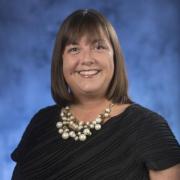From Our President. The Beginning of a Conversation

You are here
While I was growing up, my mom worked as a facilitator and organizer with volunteer community groups, organizations that supported parents, and coalitions of teens and young adults. She believed in flip charts, ground rules, and questions. She also believed that children were competent and capable, and that adults had to get out of the way and trust that the younger people in the room could come up with the answers. She still believes this today. As a result, my brothers and I grew up with flip charts, ground rules, and questions as the cornerstones of our family culture. One of my mom’s favorite questions to ask is, “What was most significant for you?” She loves this question because it has generated so many interesting and powerful responses.
I wonder how our members and partners would answer the question, “What has been most significant about your involvement with NAEYC?” What would you say? I imagine there would be a variety of perspectives and experiences; I am sure timing and context would play a role too.
Looking back over the past decade, one thing I hope we can all agree on is that this has been a transformative time for our organization. Big decisions have been made, structures have been changed, and many questions have been asked along the way—some with easy answers, many with more complicated ones. Our core beliefs in NAEYC’s Strategic Direction include excellence and innovation, transparency, reflection, equity and opportunity, and collaborative relationships. These guideposts continue to be helpful as we work to live our vision statement that “all young children thrive and learn in a society dedicated to ensuring they reach their full potential.”
In the spirit of our core beliefs and the continuing transformation at NAEYC, the Governing Board convened a leadership summit in July—“Leading and Working toward Equity.” You can read more about the summit in “Toward Equity,” by NAEYC CEO Rhian Evans Allvin, in this issue. Facilitators from the National Equity Project worked with us to clarify our desired outcomes and goals. They collected feedback and input from people in different parts of the organization as they crafted the agenda and mapped out three days of conversation and learning.
As we started, the National Equity Project provided “The Art of Conversation: Behaviors That Help Take Conversation to a Deeper Realm”:
- We acknowledge one another as equals
- We try to stay curious about each other
- We slow down so we have time to think, reflect, and feel
- We recognize that we need each other’s help to become better listeners
- We remember that conversation is the natural way that humans think together
- We expect it to get messy sometimes
I so appreciated these ground rules. It was a gift to have the time, space, structure, and thoughtful facilitation to guide us through the work.
As I reflect back, many key learnings and observations from that summit have stayed with me. One refrain that was central to our discussions was that given the chance, people can solve their own problems. This idea was connected to an article in Resurgence Magazine that we read together, “Leadership in the Age of Complexity: From Hero to Host,” by Margaret Wheatley, with Debbie Frieze. As the article so clearly states, “It is time to stop waiting for someone else to save us.” We are the ones that we have been waiting for.
Something else that struck me was how willing people were to share their personal experiences and to listen to others, speak their truths, and call out barriers and missed opportunities that have held us back. In one exercise, we worked with folks at our tables to answer the question, “What are some of the nondiscussables that we think—if we put some attention there—would move us forward on some issues that are important to us?” As we learned from a piece by Roland S. Barth, titled “The Culture Builder,”
Nondiscussables are subjects sufficiently important that they are talked about frequently but are so laden with anxiety and fearfulness that these conversations take place only in the parking lot, the rest rooms, the playground, the car pool, or the dinner table at home.
At each of our tables we made lists of nondiscussables, agreed on our top three, and wrote them on flip chart paper that was posted all over the room. There was hushed chatter as we walked around, reading other groups’ words.
We need to discuss the nondiscussables and make a plan for change.
The nondiscussables surrounded us for the rest of the day. People were eager to revisit the lists, and on day three we further explored, categorized, and prioritized them. It was powerful to see where there was agreement—it signaled opportunities for change.
This three-day meeting was the beginning of a conversation that must continue and be inclusive of our members. It can’t just happen in Washington, DC; it has to happen across our membership, Affiliates, interest forums, advisory committees and councils, staff, and Governing Board members. We will need ground rules, flip charts, and questions. We need to discuss the nondiscussables and make a plan for action and change.
We are the ones that we have been waiting for.
Note: Conversation behaviors were adapted from A. Arrien’s “The Way of the Teacher: Principles of Deep Engagement,” in Schools with Spirit: Nurturing the Inner Lives of Children and Teachers, edited by L. Lantieri (Boston: Beacon Press, 2001, pages 145–62). Roland S. Barth’s “The Culture Builder” was published in Educational Leadership (vol. 59, no. 8, pp. 6–11), in May 2002.
Photograph: © Getty Images
Amy O'Leary serves as President of the NAEYC Governing Board.
